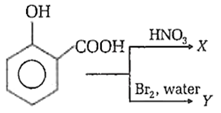 Multiple Choice Questions
Multiple Choice QuestionsCompound (A) when heated with ethyl magnesium iodide in dry ether forms an addition product, which on hydrolysis forms compound (B) Compound (B) on oxidation form 3-pantanone. Hence (A) and (B) are respectively
propanal, 3-pentanol
pentanol, 3-pentanol
ethanal, pentanol
acetone, 3-pentanol
The false statements among the following are
I. A primary carbocation is less stable than a tertiary carbocation.
II. A secondary propyl carbocation is less stable than allyl carbocation.
III. A tertiary free radical is more stable than a primary free radical.
IV. Isopropyl carbanion is more stable than ethyl carbanion.
I and II
II and III
I and IV
II and IV

X and Y in the above given reaction are
picric acid, 2,4, 6-tribromophenol
5-nitrophenol acid, 5-bromosalicylic acid
o-nitrophenol, o-bromophenol
3, 5-dinitrosalicylic acid, 3,5-dibromosalicylic acid
The reaction of 1-bromo-3-chlorocyclobutane with metallic sodium in dioxane under reflux conditions gives
![]()
![]()
![]()
![]()
Identify Z in the following reaction sequence
CH3CH2CH2OH X → Y
CH3-CH(NH2)-CN2NH2
CH3-CHOH-CH2OH
CH3-C(OH)=CH2
CH3-C≡CH
Which of the following reactions is used to prepare isobutane?
Wurtz reaction of C2H5Br
Hydrolysis of n-butylmagnesium iodide
Reduction of propanol with red phosphorus and HI
Decarboxylation of 3-methylbutanoic acid
D.
Decarboxylation of 3-methylbutanoic acid
Decarboxylation of 3-methylbutanoic acid gives isobutane i.e.,
CH3-CH(CH3)-CH2COOH CH3-CH(CH3)-CH3 + CO2 ↑
On the other hand, Wurtz reaction of C2H6Br gives n-butane, hydrolysis of n-butyl magnesium bromide also gives n-butane but reduction of propane! with HI/P gives propane.
Treating anisole with the following reagents, the major product obtained is
I. (CH3)3CCl, AlCl3
II. Cl2, FeCl3
III. HBr, Heat




Glycerol A B
A and B respectively are
CH2=CH ; H2-C(OH)HCOH
CH2=CHCOH; C(OH)H2-C(Cl)HOCH
CH3CH2CHO; CH3CH2CH(OH)(Cl)
CH2=CHCOH; C(Cl)OH2CH2CHO
